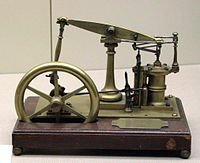
Photo from wikipedia
Abstract The engine boosting system is one of the advanced technologies for engine downsizing. It reduces polluting emissions for diesel and gasoline engines. Double entry turbine turbocharger technology, typically used… Click to show full abstract
Abstract The engine boosting system is one of the advanced technologies for engine downsizing. It reduces polluting emissions for diesel and gasoline engines. Double entry turbine turbocharger technology, typically used in diesel engines pressure boosting, plays a key role in improving horsepower and reducing wave interference between cylinders. The present work attempts to contribute to the knowledge of the double-entry turbine behavior for gasoline engines by the means of a comparative study between in-phase and out-phase admission modes. The turbine is modeled under the entire range of the gasoline engine flow pulse frequency from 33.33 Hz up to 200 Hz. From the numerical results, it was revealed that the outer limb of the double-entry turbine has a lower ability to swallow flow from the engine exhaust manifold compared to the inner limb under the out-phase admission mode. In this condition, the turbine total-to-static efficiency is increased by 10% compared to the in-phase admission mode. The results revealed a significant reduction in the hysteresis loop area of the total-to-static efficiency up to 35% under the out-phase admission mode.
Journal Title: Energy
Year Published: 2021
Link to full text (if available)
Share on Social Media: Sign Up to like & get
recommendations!